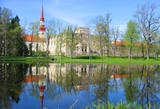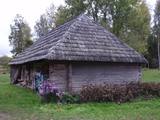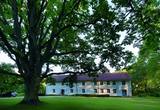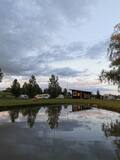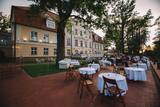| Nr | Name | Beschreibung |
|---|---|---|
|
Этот тур рассчитан на семейный отдых. В нем культурные и природные достопримечательности сбалансированы с множеством забав для детей. Маршрут включает в себя несколько ферм, где можно понаблюдать за домашними животными и Природные тропы Лигатне, где можно увидеть диких животных. На пути есть несколько средневековых замков и живописных городов. Побережье моря встретит Вас песчаными пляжами и рыбацкими деревушками, где Вы сможете отведать копченой рыбы. Национальные парки Гауя и Слитере предложат Вам несколько природных троп и живописные пейзажи. |
||
|
Das Hotel befindet sich in Piedruja am Fluss Daugava, der hier der Grenzfluss zwischen Lettland und Weißrussland ist. Hier werden lettgallische Gerichte, sowie Abende im lettgallischen, weißrussischen und polnischen Stil angeboten. Lettische Küche: Gerichte aus Süßwasserfischen. Gebratener Wels. Das besondere Gericht: Gefüllter und im Ofen gebackener Hecht. |
||
|
Jau pēc dievnama veidola var spriest, ka vēl ne tik sen – padomju laikos ēka bija izmantota citām vajadzībām. Pēc 2. pasaules kara to atsavināja draudzei, bet torni – uzspridzināja, dievnamā ierīkojot noliktavu. 20. gs. deviņdesmitajos gados draudze uzsāka baznīcas atjaunotni un tagad tā kalpo savam pamatmērķim. |
||
|
The viewing tower is in a seaside meadow near Mērsrags. It is an unusual type of biotope in Latvia and is located to the North of the Mērsrags port. The tower offers a good view of reed-filled meadows, areas where wild cattle have grazed, and an amazing wealth of different kinds of plants. |
||
|
Die Festungsburg Põltsamaa wurde am Flussufer im 13.Jh errichtet und im 16. Jh. diente die Burg als Residenz des Liwischen Königs Magnus. Im Schloss befinden sich die Touristikinfo, das Museum Põltsamaa, Weinkeller mit Lebensmittelmuseum, Estlands Pressemuseum, Galerie pART, Keramikwerkstatt und Handarbeitsstube. |
||
|
Die Besitzer zuchten Shiitakepilze in einem Wald und bieten eine Exkursion mit Erzählung über die Zucht der Pilze und ihre gute Eigenschaften an. Erwerb der Pilze, Beratung. Die Besitzer bieten ökologische landwirtschaftliche Produkte und Honig an.
|
||
|
Eine gut eingerichtete Strecke des Flusses Driksa (ein Nebenarm des Flusses Lielupe) mit einer zweistufigen Promenade, der im Baltikum einzigartigen Brücke Mītava, Aussichtsplätzen, dem Denkmal Student von Jelgava u.a. |
||
|
Atrodas Inciema centrā. Piedāvā maltīti visām ēdienreizēm. Lielas porcijas, garšīgs ēdiens. Iecienīta tuvākas un plašākas apkaimes maltītes ieturēšanas vieta. Klāj galdus. |
||
|
The owners have made sure that everyone can buy fresh and processed fishery products from local producers. During the summer, on the terrace, you can listen to Mazupīte's water, enjoy freshly grilled fish, as well as enjoy particularly delicious cakes, coffee and ice cream. |
||
|
This is the home of singer and oral tradition keeper Lidija Jansone, who is a holder of the Latvian Order of Tree Stars and a fierce defender of the cultural heritage of the Suiti people. She will tell you about her community’s history and traditions and about the special bourdon singing of the Suiti. Lidija will also talk about how beer was once brewed by our ancestors for various celebrations. |
||
|
Das Café befindet sich im Zentrum von Aglona an der Straße nach Dagda (P 60). Lettische Küche: Schweinefleischfrikadellen, Kartoffeln mit Hering und Sauerrahm, Quarkcreme mit Erdbeeren. Das besondere Gericht: Rouladen. |
||
|
Auf dem Hof Untumi werden eine Pferdeherde gehalten und gezüchtet, sowie Pferde gekauft, die den Anforderungen der historisch gezüchteten lettischen Pferderasse entsprechen. Hier kann man in einem Pferch oder in der Umgebung des Hofes unter der Leitung eines Instrukteurs Reitfertigkeiten erlernen. Im Sommer kann man hier mit einem Pferdewagen, aber im Winter – mit einem Pferdeschlitten fahren. Die Pferde werden zu Hochzeiten und anderen Veranstaltungen verwendet. |
||
|
This workshop manufactures belts, bags, jewellery (pendants, brooches, bracelets), as well as covers. It offers book binding services and prepares souvenirs. Tours are available for groups of up to 50 people. You can try your own hand at the crafts, taste teas, and cook soups on an open fire. |
||
|
Das Wirtshaus befindet sich am Ufer des Sees Aluksne, im Zentrum für Landtourismus und Erholung Jaunsētas. Es ist ein Blockhaus mit Innenausstattung im Stil des 17. Jhs., als in Aluksne die spätere Zarin von Russland und die Frau des Peters des Großen geboren wurde und bei ihrem Pflegevater Ernst Glück aufgwuchs. Lettische Küche: Suppe aus Fischen (Zander oder Hecht) aus dem See Aluksne, Schweinezunge, in Mehlpanierung gebratenes Ei, geschichtetes Roggenbrot-Dessert mit Preiselbeermarmelade und Schlagsahne. Das besondere Gericht: Mittagessen nach dem Geschmack der örtlichen Einwohner: Brühe mit gebrühten Teigstücken "Profitroļi". |
||
|
The first mention of Pēterupe Rectory goes back to the late 17th century. The Manor Park and the buildings have partially survived to the present day, including a linden alley at the end of Smilšu Street, planted by the pastor Jānis Neilands in 1879 and the grand oak planted by Johann Wilhelm Knierim in 1869. After the fire of 1908, the Rectory was restored and partially rebuilt. In Soviet times, the property was removed from the parish and the house was named “Līgotnes”. During German times the Rectory was occupied by legionnaires. After the war, the building of the Rectory was turned into a hospital, then into a secondary school and later it was transformed into a block of flats for teachers. Now the building again belongs to the parish and it is inhabited by a priest of the parish and his family. |
||
|
Lakeside Sigulda is a quiet camping and recreation area on the territory of Lake Matinu. Offers relaxation, overnight stays near nature and picnic options in a quiet environment. Travelers with campers, caravans, as well as those staying in tents can stay overnight in the camping area. In addition, a well-equipped glamping tent for 2 people has also been created. Showers, toilets, outdoor kitchen, picnic areas, grills, internet and electricity connection are available for camping guests. SUP boards are available for active recreation. |
||
|
The restaurant is situated in the guest house Liedags alongside the Liepaja-Ventspils highway, 4,5 km away from Jurkalne on the banks of Enavite river. |
||
|
Saimnieki piedāvā vietu, kur aizbraukt brīvā laika pavadīšanai, atpūtā ģimenei Kurzemē. Šeit viesiem ir iespēja aplūkot sākot no dažādu laiku lauksaimniecības tehnikas un darbarīkiem, līdz pat kara laika paliekām, kā arī dažādu laiku sadzīviskos priekšmetus. Katram priekšmetam seko arī stāsti, kas ir piedzīvoti vai tikai dzirdēti. Tāpat apmeklētājiem ir iespēja apskatīt mājas iemītniekus,kas ir veidoti ar pašu rokām. Asākām un patīkamākām sajūtām pieejama 350 metrus gara Baskāju taka. |
||
|
Das Restaurant befindet sich in dem 2008 renovierten Gebäude des Landguts Mālpils, das als Baudenkmal des Klassizismus aus dem 19. Jh. gilt. Die Speisekarte des Restaurants wird ständig geändert und mit saisonalen Gerichten ergänzt. Eine Kombination aus feinen Geschmäcken und einem eleganten Ambiente des Landguts. Lettische Küche: Käse von Mapils, Pilzsuppe, Wildbret, gebratener Zander, Roggenbrot-Dessert. Das besondere Gericht: Eis des Landgutes von Malpils. |
||
|
Latvia is among one of the world’s three most important bird migration paths, and during migration seasons tens of thousands birds can be seen at one place. The tour will spent significant time along the sea coast in order to catch the highlights of migration. In spring time also flood-lands become alive with activities of thousands of birds and provide great atmosphere for birdwatchers. This tour explores different biotops to get the best impressions of the spring time migration. |
||




